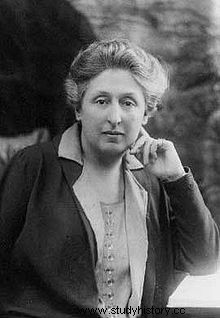Cécile Kahn, now Cécile Brunschvicg (1877 – 1946) was a French politician and feminist. In 1936, she was one of the first three women to be part of a French government, along with Irène Joliot-Curie and Suzanne Lacore, when women did not yet have the right to vote.
Secret studies
 Daughter of Arthur Kahn, Alsatian industrialist, Cécile Kahn was born on July 19, 1877 in Seine-et-Oise. She grew up in a bourgeois Jewish and Republican family, where women were not supposed to study. Cécile therefore studied in secret, obtaining her higher patent at the age of seventeen against her father's wishes.
Daughter of Arthur Kahn, Alsatian industrialist, Cécile Kahn was born on July 19, 1877 in Seine-et-Oise. She grew up in a bourgeois Jewish and Republican family, where women were not supposed to study. Cécile therefore studied in secret, obtaining her higher patent at the age of seventeen against her father's wishes.
In 1899, Cécile married Léon Brunschvicg, feminist philosopher and idealist member of the League of Human Rights, with whom she had four children. With him, she began to campaign for women's rights, and in particular for women's suffrage. She also fights for equal rights at work between men and women:equal pay, access to all professions, refusal of any hindrance to the work of mothers...
Under-Secretary of State for National Education
Within the French Union for Women's Suffrage (UFSF), Cécile Brunschvicg gradually gained influence until becoming its president in 1924. She also joined the International Council of Women and the International Alliance of Women for Women's Suffrage. Involved in politics, Cécile joined the Republican, Radical and Radical-Socialist Party (or PRS) in 1924. She actively participated in the Estates General of Feminism in 1929.
In 1936, appointed Under-Secretary of State for National Education in the Blum government, Cécile Brunschvicg was, along with Irène Joliot-Curie and Suzanne Lacore, one of the first women to be part of a French government. In this position, she created school canteens, developed monitoring of health risks and promoted girls' education.
During the Second World War, because of her Jewish origins, Cécile hid in the South of France where she became a teacher in a boarding school for young girls. At the end of the war, she recreated the UFSF.
Cécile Brunschvicg died in Neuilly-sur-Seine on October 5, 1946. She was decorated with the Legion of Honor in 1937.
